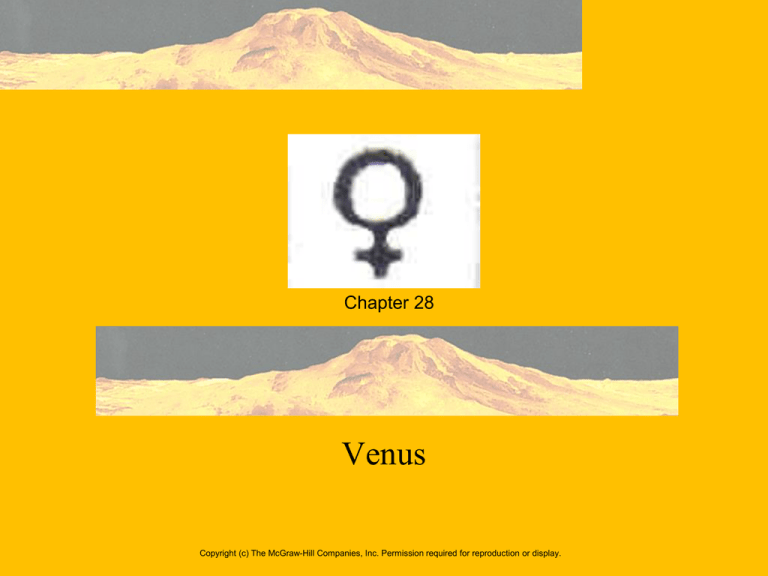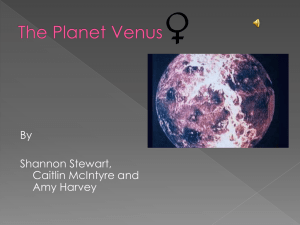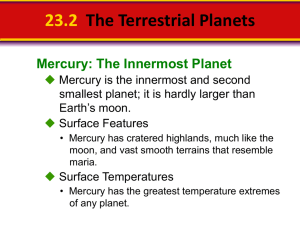Venus pp Notes
advertisement

Chapter 28 Venus Copyright (c) The McGraw-Hill Companies, Inc. Permission required for reproduction or display. Venus – not so twinlike after all! Roman: Goddess of love and our twin sister This is the second planet from the Sun Mostly known as our twin sister But only in Size, Density, escape velocity & surface gravity only. Venus – not so twinlike after all! Roman: Goddess of love and our twin sister Brightest of all the planets in the night sky from earth. Venus is often termed the “Morning Star” and the “Evening Star.” 8000 miles Venus – not so twinlike after all! 7950 miles • Venus is only slightly smaller than the Earth (about 0.95%), but Venus is only slightly smaller than the Earth (about 0.95%), Venus – not so twinlike after all! • Venus is only slightly smaller than the Earth (about 0.95%), but that is where the resemblance stops! – Thick clouds completely obscure the surface Venus – not so twinlike after all! – The surface is tremendously hot! – ~896º Fahrenheit – ~480º Celsius – ~718 Kelvin Rotation of Venus • Of all the planets, Venus spins about its axis the slowest – 243 days to complete one rotation Rotation of Venus • Of all the planets, Venus spins about its axis the slowest – 243 days to complete one rotation – Slow rotation creates almost no magnetic field! https://www.youtube.com/watch?v=AgnbAcT4iMk Rotation of Venus • This retrograde rotation cannot be produced by tidal braking – Perhaps a collision early in its history tipped its axis Rotation of Venus • Venus Revolution is 224.70 days (225 days) – MEANS: a year is shorter than a day The Venusian Atmosphere • The atmosphere of Venus is very different from Earth’s: – 100 times more thicker – Surface pressure is 90 atmospheres! – 96.5% carbon dioxide The Venusian Atmosphere • The atmosphere of Venus is very different from Earth’s: – Thick clouds of sulfuric acid (H2SO4) – Trace amounts of water vapor & N2 The Venusian Atmosphere • The planet probably underwent a runaway greenhouse effect • The planet has a yellowish sky. The Venusian Atmosphere The Venusian Atmosphere • Lightning storms have been spotted on Venus • Scientist estimate that there is 100,000,000 volts of electricity in a lightning bolt on Venus – THEY never touch the ground!!!! Interesting features of the surface of Venus •Venus has enormous upside-down vortices spinning over both poles of the planet. •Unlike Earth-based tornadoes and hurricanes, which suck upward, these vortices recycle the atmosphere downward. •Furthermore, the north pole of Venus has not one but two of these vortices! Images from Venus • The Russian Venera spacecraft have visited the surface of Venus – Surface temperatures of ~718K, hot enough to melt lead! – Discovered volcanic rocks Images from Venus • The spacecraft only lasted about an hour due to the extreme temperatures and pressure • More recent spacecraft have mapped the surface of Venus from orbit The Surface of Venus • Venus has both highlands and lowlands The Surface of Venus • Surface features are named for prominent women in history and mythology The Surface of Venus • Venus is less mountainous than Earth, with more rolling plains The Surface of Venus • Volcanic peaks are present in the highlands The Surface of Venus • Volcanic peaks are present in the highlands Recent radar map of Venus • The surface of Venus seems to be relatively young • Not sure is volcanic activity resurfaces the planet rapidly or not. • No Volcano has been actually detected erupting but,,, Recent radar map of Venus • Evidence in 2010 did show in the clouds a “white” spot” which is believed to be caused by a volcano erupting. • There are a few impact craters, due both to the thick atmosphere and perhaps volcanic activity. Interesting features of the surface of Venus Recent radar map of Venus • Diameter – 7,530 miles; 12048 Km – 0.95 than earth • Composition: – Solid Fe, Ni core like earth’s – Magnetic field does not exist due to retrograde rotation. – Mantle may contain hotspots but not sure Recent radar map of Venus • Tilt of 3 degree • Incline plane of 3.4 degrees • Average Distance from Sun – .723 AU (.7 AU) – 67,000,000 miles 67,239,000 Venus









